
The Aizoaceae, or fig-marigold family, is a large family of dicotyledonous flowering plants containing 135 genera and about 1800 species. They are commonly known as ice plants or carpet weeds. They are often called vygies in South Africa and New Zealand. Highly succulent species that resemble stones are sometimes called mesembs.

Lampranthus is a genus of succulent plants in the family Aizoaceae, indigenous to southern Africa.
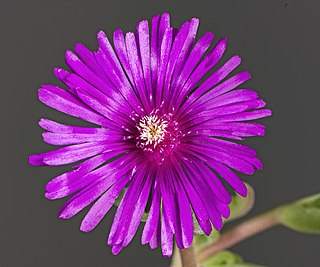
Delosperma is a genus of around 170 species of succulent plants, formerly included in Mesembryanthemum in the family Aizoaceae. It was defined by English botanist N. E. Brown in 1925. The genus is common in southern and eastern Africa. Delosperma species, as do most Aizoaceae, have hygrochastic capsules, opening and closing as they wet and dry.
This page provides a glossary of plant morphology. Botanists and other biologists who study plant morphology use a number of different terms to classify and identify plant organs and parts that can be observed using no more than a handheld magnifying lens. This page provides help in understanding the numerous other pages describing plants by their various taxa. The accompanying page—Plant morphology—provides an overview of the science of the external form of plants. There is also an alphabetical list: Glossary of botanical terms. In contrast, this page deals with botanical terms in a systematic manner, with some illustrations, and organized by plant anatomy and function in plant physiology.
This glossary of botanical terms is a list of definitions of terms and concepts relevant to botany and plants in general. Terms of plant morphology are included here as well as at the more specific Glossary of plant morphology and Glossary of leaf morphology. For other related terms, see Glossary of phytopathology and List of Latin and Greek words commonly used in systematic names.
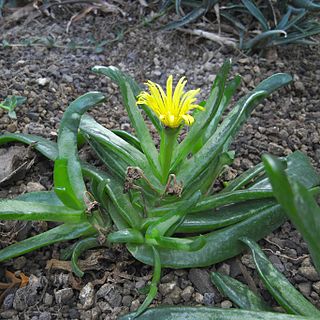
Glottiphyllum is a genus of about 57 species of succulent subtropical plants of the family Aizoaceae. It is closely related to the Gibbaeum and Faucaria genera. The name comes from ancient Greek γλωττίς glottis "tongue" and φύλλον phyllon "leaf". The species are native to South Africa, specifically to Cape Province and the Karoo desert. They grow in rocks and soils incorporating slate, sandstone and quartz. Rainfall in their native areas is between 125 and 500 mm, most of which falls in March and November.

Glottiphyllum longum is a species of succulent plant in the family Aizoaceae, native to the Western Cape and Eastern Cape Provinces, South Africa.
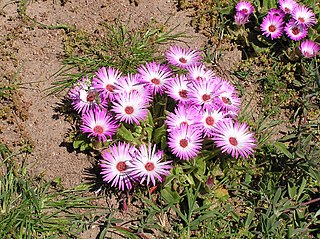
Cleretum bellidiforme, commonly called Livingstone daisy, Bokbaaivygie (Afrikaans), or Buck Bay vygie, is a species of flowering plant in the family Aizoaceae, native to the Cape Peninsula in South Africa. It is a low-growing succulent annual growing to 25 cm (10 in), and cultivated for its iridescent, many-petalled, daisy-like blooms in shades of white, yellow, orange, cream, pink and crimson. In temperate areas it is popularly grown as a half-hardy annual, and lends itself to mass plantings or as edging plants in summer bedding schemes in parks and gardens. It is still widely referenced under its former names, Mesembryanthemum criniflorum and Dorotheanthus bellidiformis.

Glottiphyllum cruciatum is a rare species of succulent plant, of the family Aizoaceae. It is indigenous to arid areas near Oudtshoorn in the Western Cape, South Africa. The plant has many synonyms including Glottiphyllum angustum.
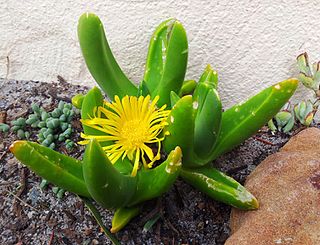
Glottiphyllum regium is a rare species of succulent plant, of the family Aizoaceae. It is known locally as "koeispene". It is restricted to a small arid area near Calitzdorp in the Western Cape, South Africa.
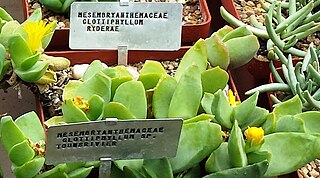
Glottiphyllum linguiforme is a widespread species of succulent plant, of the family Aizoaceae, native to South Africa. It is the type species of the genus Glottiphyllum.

Glottiphyllum surrectum is a species of succulent plant, of the family Aizoaceae. It is indigenous to arid areas of the Little Karoo, in the Western Cape, South Africa.
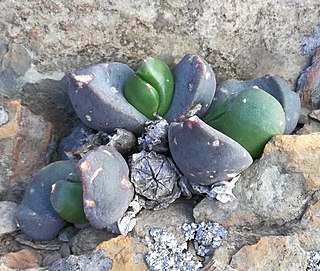
Glottiphyllum suave is a species of succulent plant, of the family Aizoaceae. It is indigenous to arid areas of the western Little Karoo, in the Western Cape, South Africa.

Glottiphyllum oligocarpum is a species of succulent plant, of the family Aizoaceae. It is indigenous to arid areas of the Little Karoo, in the Western Cape, South Africa.

Glottiphyllum fergusoniae is a species of succulent plant, of the family Aizoaceae. It is indigenous to the western part of the Little Karoo, in the Western Cape, South Africa.

Glottiphyllum nelii is a species of succulent plant, of the family Aizoaceae. It is indigenous to the arid Great Karoo region, South Africa.
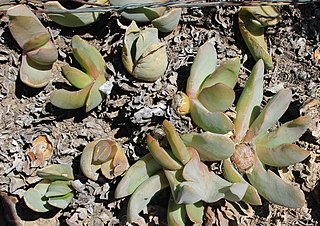
Glottiphyllum carnosum is a rare species of succulent plant, of the family Aizoaceae. It is indigenous to arid areas between the towns of Calitzdorp and Oudtshoorn in the Western Cape, South Africa. It co-occurs with several other species of Glottiphyllum.

|}}

Drosanthemum lavisii is a succulent plant in the ice plant family, Aizoaceae, indigenous to the Overberg region of the Western Cape Province, South Africa.

Trichodiadema barbatum is succulent plant of the genus Trichodiadema, native to the Eastern Cape Province, South Africa.























